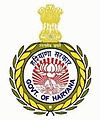Haryana (State of Haryāna)
 |
Haryana contains 32 special economic zones (SEZs), mainly located within the industrial corridor projects connecting the National Capital Region. Gurgaon is considered one of the major information technology and automobile hubs of India. Haryana ranks 11th among Indian states in human development index. The economy of Haryana is the 13th largest in India, with a gross state domestic product (GSDP) of inr 7650000000000 and has the country's 5th-highest GSDP per capita of inr 240000.
The state is rich in history, monuments, heritage, flora and fauna and tourism, with a well-developed economy, national highways and state roads. It is bordered by Punjab and Himachal Pradesh to the north, by Rajasthan to the west and south, while river Yamuna forms its eastern border with Uttar Pradesh. Haryana surrounds the country's capital territory of Delhi on three sides (north, west and south), consequently, a large area of Haryana state is included in the economically important National Capital Region of India for the purposes of planning and development.
Anthropologists came up with the view that Haryana was known by this name because in the post-Mahabharata period, the Abhiras live here, who developed special skills in the art of agriculture. According to Pran Nath Chopra, Haryana got its name from Abhirayana-Ahirayana-Hirayana-Haryana.
Map - Haryana (State of Haryāna)
Map
Country - India
 |
 |
| Flag of India | |
Modern humans arrived on the Indian subcontinent from Africa no later than 55,000 years ago. Their long occupation, initially in varying forms of isolation as hunter-gatherers, has made the region highly diverse, second only to Africa in human genetic diversity. Settled life emerged on the subcontinent in the western margins of the Indus river basin 9,000 years ago, evolving gradually into the Indus Valley Civilisation of the third millennium BCE. By, an archaic form of Sanskrit, an Indo-European language, had diffused into India from the northwest. (a) (b) (c), "In Punjab, a dry region with grasslands watered by five rivers (hence ‘panch’ and ‘ab’) draining the western Himalayas, one prehistoric culture left no material remains, but some of its ritual texts were preserved orally over the millennia. The culture is called Aryan, and evidence in its texts indicates that it spread slowly south-east, following the course of the Yamuna and Ganga Rivers. Its elite called itself Arya (pure) and distinguished themselves sharply from others. Aryans led kin groups organized as nomadic horse-herding tribes. Their ritual texts are called Vedas, composed in Sanskrit. Vedic Sanskrit is recorded only in hymns that were part of Vedic rituals to Aryan gods. To be Aryan apparently meant to belong to the elite among pastoral tribes. Texts that record Aryan culture are not precisely datable, but they seem to begin around 1200 BCE with four collections of Vedic hymns (Rg, Sama, Yajur, and Artharva)."
Currency / Language
| ISO | Currency | Symbol | Significant figures |
|---|---|---|---|
| INR | Indian rupee | ₹ | 2 |
| ISO | Language |
|---|---|
| AS | Assamese language |
| BN | Bengali language |
| BH | Bihari languages |
| EN | English language |
| GU | Gujarati language |
| HI | Hindi |
| KN | Kannada language |
| ML | Malayalam language |
| MR | Marathi language |
| OR | Oriya language |
| PA | Panjabi language |
| TA | Tamil language |
| TE | Telugu language |
| UR | Urdu |















